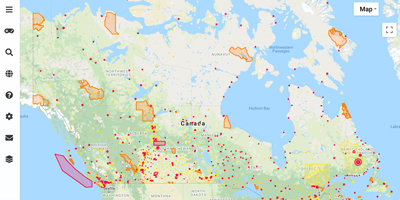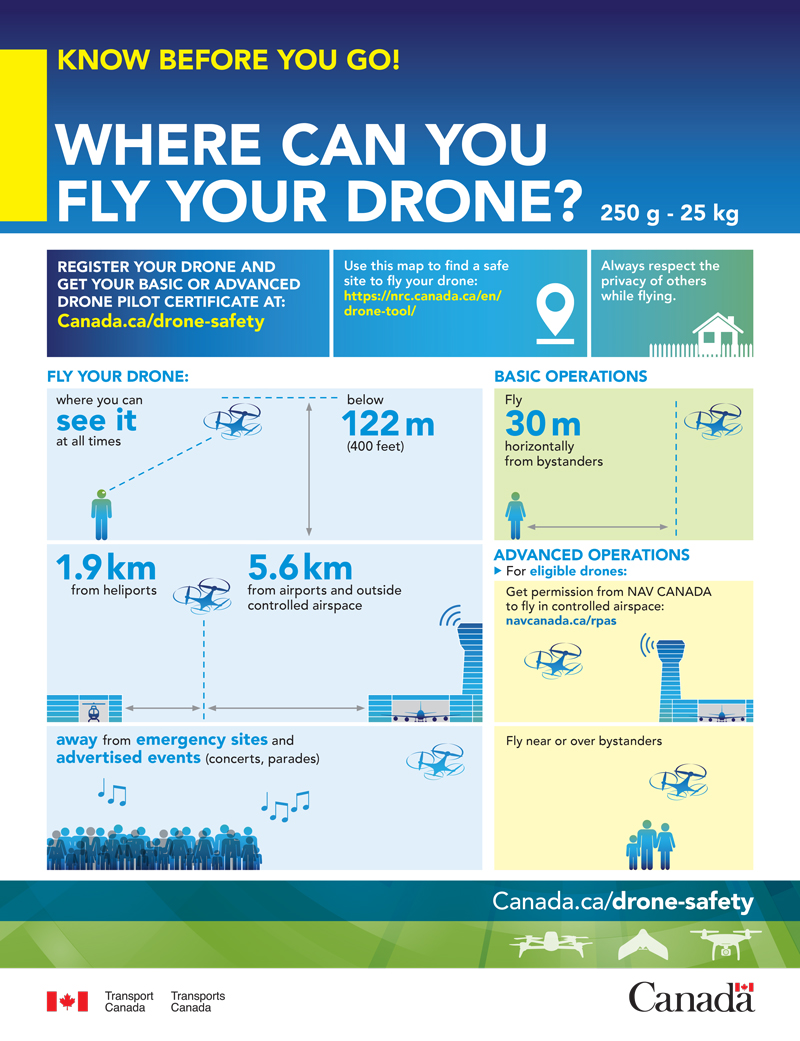Transportation Canada Information
Where Can I Fly My Drone?
DroneStripe Ltd. currently only provides UAV information specific to Canada. We are currently collecting international UAV information which will be added to the site in future updates.
Sharing Airspace
Prior to each flight, drone pilots must conduct a survey of the area and also consult:- Notice to Airmen (NOTAMs) for the flight location
- Canada Flight Supplement
- Designated Airspace Handbook
- Appropriate Aeronautical Charts
Controlled Airspace
Drone pilots must get air traffic control approval for operations in controlled airspace. For airspace controlled by NAV CANADA, request a RPAS Flight Authorization . For controlled airspace under the authority of the Minister of National Defence (MND), you must request a flight authorization from the appropriate aerodrome authorities, this information can be found in the Canada Flight Supplement (CFS) or on the NRC Drone Site Selection Tool . To operate within controlled airspace, the pilot needs an advanced RPA pilot certificate , a drone with the appropriate manufacturer safety declaration and the air navigation service provider approval. Drone pilots must maintain communications with the air traffic control authority while flying. For more information on operations in controlled airspace, please visit section 3.4.4 of the RPA chapter of Transport Canada Aeronautical Information Manual (AIM) .Areas That Limit the Use of Drones
Airports, heliports and aerodromes
An aerodrome is anywhere that an aircraft can take off and land. This includes airports, heliports, and seaplane bases.
Unless you are following an established Transport Canada procedure, you cannot fly closer than:
- 5.6 kilometres (3 nautical miles) from any airport listed as Certified (“Cert”) in the Canada Flight Supplement
- 1.9 kilometres (1 nautical mile) from heliports listed as Certified (“Cert”) in the Canada Flight Supplement
Airport, water airport or heliports outside of controlled airspace
Drone pilots planning to fly in uncontrolled airspace, and within 3 nautical miles of a certified airport, or within 1 nautical mile from a certified heliport must always have a valid drone pilot certificate – advanced operations and comply with Transport Canada established procedures. Transport Canada established procedures can be found in the section 3.4.5 of the RPA chapter of Transport Canada Aeronautical Information Manual (AIM), and on the NRC Drone Site Selection tool.
Operations within 3 nautical miles of a Department of National Defense (MND) aerodrome
Drone operations within 3 nautical miles (5.6 kilometers) of an aerodrome under the authority of the MND require a Special Flight Operations Certificate (SFOC) – RPAS. To be issued an SFOC-RPAS, the drone pilot must receive authorization from the MND aerodrome authorities.
For more information about these zones and how to properly access them, please consult the NRC Drone Site Selection tool and section 3.2.35 of the RPA chapter of Transport Canada Aeronautical Information Manual (AIM) .
National Parks
Drone pilots are not allowed to take-off or land within a national park.
A park superintendent may allow the use of drones in some cases. If you want to fly a drone in a national park, read about the use of drones at Parks Canada places and contact Parks Canada .
Emergency Sites
Drone pilots are not allowed to fly within the security perimeter of a police or first responder emergency operation, such as a traffic accident. You must also avoid sites near disasters (forest fires, floods, earthquakes). A drone flying near these areas may interfere with emergency personnel aircraft and the work of emergency personnel.
Advertised Events
Drone pilots are not allowed to fly near or over advertised events, such as outdoor concerts and sporting events, unless they have a Special Flight Operations Certificate that specifically allows them to do so.
Indoors, Near and Over Buildings
Part IX of the Canadian Aviation Regulations do not apply to indoor or underground drone operations. No matter where you fly, however, you must fly safely and always respect all other laws so as not to pose dager to people or other aircraft. Before you fly indoors, or near or over buildings, we recommend getting permission from the building owner and/or occupants.



